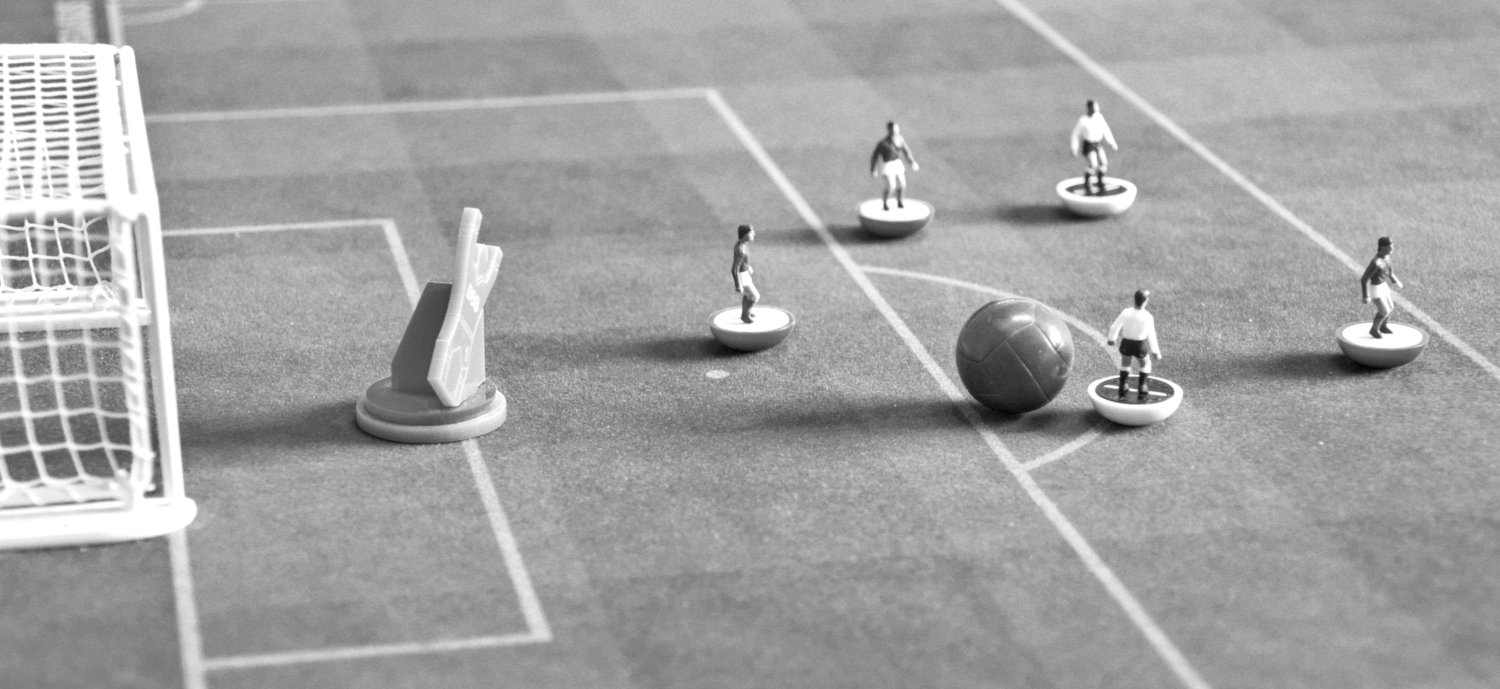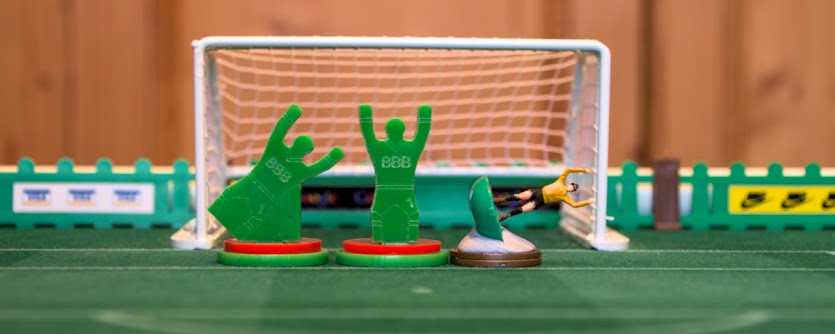Regrouping the Defence
Now not everyone plays to my quirky rules, and I’ve tried to imagine if there was a way to allow a defence to regroup after they gain possession in their own shooting area, instead of remaining static in their current position.
So What Can We Do?
Modern rules seem to ignore this, relying on the continuous blocking method, and players chasing each other around the table, which does little to get a sense of order behind the ball especially when the defence come away with it. Back in the 60’s there was a rule that allowed the team in possession to reorganise their defence (taken from the 1969 rules), as follows:
Rule 7 – Defence.
(a) Only 3 figures may be placed in the defence area during a kick-off or free-kick, unless the free-kick is taken INSIDE the defence area by the attacking side, in this case 4 figures may be positioned.
(b) When the ball is in their possession, a side may organise and bring up up to 3 figures into their area, providing the ball is NOT in their area. If there are 3 or more figures are ALREADY in the area, a player may not move figures into it, but may position 3 of the figures already there.
(c) Figures may not be placed inside the goalkeepers area, No figure may be positioned if the ball is in the area of either half.
 |
| Bolton Wanderers take on Man United in the 1958 cup final to trial the regrouping rule |
Don’t you just love these 50 odd year old rules, why use 1 word when 20 will do and at times confuse the hell out of the reader. So to sum up, if you are in possession of the ball between the shooting areas you can reorganise your defence by picking up and placing players in your own shooting area, if there are less than 3 already there you can place 3 more in there, if 3 or more are already there you can only move 3 of those already there.
I think we can probably disregard (a), because at that time free kicks were treated in a similar way to goal kicks, you could organise your whole field, but couldn’t place them in the opposing shooting area. A little different to the 2 flicks we probably use now, that came in, in the mid 70’s.
Considering My Options
If we look at (b), and (c), we now have something to work with, it allows the defence to organise itself after coming away with ball, but the execution I feel needs a revamp so it becomes easy to implement in a solo game, also I’m against the idea of picking up and precisely positioning defenders at anytime during open play.
So after some thought, and a general kick about, I started trialing one or two different methods to see if I could go some way to restoring a little order into a defensive line quickly if needed without disrupting the flow.
An Idea in Practice
After a few failed attempts, I came up with the following:
Regrouping the Defence
(a) When a team gains possession inside it’s own area, as soon as they play the ball outside of the area, providing they are still in possession and the ball remains in their half. 2 defenders already inside the area may be repositioned by flicking if required. Any player positioned this way must remain inside the area, and cannot play the ball immediately until played by a teammate.
(b) All regrouping flicks must end up inside the area or the player is put back to its original position and the flick is lost.
(c) Figures outside the shooting area may not be regrouped.
(d) Regrouping is never allowed when the flicking keeper is in play.
Rule (a) sets the parameters for regrouping, a team must have gained possession inside their area, a team cannot regroup until the ball is outside of the area, they remain in possession, and the ball is in their half, and it must be done immediately the ball leaves the area or not at all.
Under my rules a team would gain possession in their area If, the attack miss the ball, a defender is the last player to touch the ball, they are the nearest team to the ball after a shot, or the keeper makes a save and the ball remains inside the keepers area.
Now flicking keepers have their own set of rules, and I don't want to change them, so I’ve decided that regrouping is not allowed when a keeper clears the ball outside of the shooting area. So in short if the flicking keeper is on the pitch regrouping is not possible. Does any of this make sense?
If not I’ll try and explain further with a few examples.
i) A side plays plays the ball outside of it’s shooting area into it’s own half, (after taking possession inside of the shooting area, and remain in possession outside). It has 4 defenders in it’s shooting area, they then have the option of repositioning 2 of those players inside their shooting area.
ii) A side plays plays the ball outside of it’s shooting area into it’s own half, (after taking possession inside of the shooting area, and remain in possession outside). it has 1 defender in it’s shooting area it can only reposition that single player with a single flick.
iii) A flicking keeper clears the ball outside of the shooting area. Regrouping is not allowed because the flicking keeper is still in play (under my current rules), even if the clearance touches a teammate.
iv) Regrouping is not allowed if the opposition play the ball and the defence deflect the ball outside of the shooting area, the defence must play the ball out whether deflected or not.
All of the above examples are obviously based on my current rules, and how they integrate within that framework. So your mileage may vary under your own particular rule set.
Does it Work?
After I trialed it in a kick about, I decided to give it a go in a match. So to give the match a reason to be played I replayed the 1958 Cup Final, the result wasn’t changed Bolton Wanderers still won this time 3-2 in a game that was heading for extra time after Manchester United had twice been in front but did not ironically manage to defend a corner at the death, which led to the Bolton winner. But the main reason was give the regrouping rule a run out. Did it work? I felt it changed things slightly, it didn’t alter the game that much, which is good in one respect. It was more visually pleasing as teams came out of defence, and were able to regroup to a certain extent, it also had the effect of making attackers offside at times, affording the defence more defensive flicks at the time the attackers were allowed to be flicked onside under my current rules.
It made me think a little differently without actually changing much in the way of tactics. It also allowed defences to try and plug gaps when they come away with the ball as they were afforded the luxury of possibly getting a couple of their misplaced players back into a familiar position. The biggest problem was remembering to do it, nothing new with a new rule, but if Bolton had remembered Manchester United may not have scored their second goal.
I don’t want a rule that cuts the chances down too much, and it didn’t seem to on this showing. It helped slightly my limited defensive flicks without too much disruption to the flow of the game. So I feel at this juncture it could play a part in the future. It’s at most two extra flicks which is quick to do, it only comes into play if a team gain possession in their own shooting area, and it doesn’t change my flicking keeper rules.
Whether or not this idea would work for anyone but me is entirely up to the individual concerned, it may give some a little food for thought. I feel personally it could work, but I’m not 100% certain until I’ve played a few more games, what do you think?
Keep on Flicking
Ian



I've always liked the "organising" rule, although recently I've modified it to "limited organising" which is almost identical to the "regrouping" you've described.
ReplyDeleteI never got used to flicking the defenders though, and after several attempts with some trial matches, have always reverted to positioning by hand.
Having defenders in authentic positions when play is further upfield gives the game a more realistic appearance.
I've always felt placing in open play to me is not in the spirit of the game, but placed or flicked as long as it does what it's intended to achieve is all that matters. I find flicking a little random at times as opposed to precise placement which I like in solo play. But as they say each to their own we only have ourselves to please.
ReplyDeleteInteresting stuff as always gents -
DeleteFlicking keepers now there’s another topic ! Until I started venturing out of town to play I’d never seen or used one - we don’t use them locally
Can’t sign in for some reason - anyway we are on our close season now so enjoy the summer regards Ralph
ReplyDeleteHi Ralph, I know where you're coming from regarding flicking keepers, at the club back in the day we all had them and used them for goal kicks, and they were replaced after taking the kick. It wasn't until I started playing solo a couple of years ago that I let them have more involvement due to the way I approached solo goalkeeping in my games. So it's basically 70's Rules with a little home brew adaption.
DeleteYes they’re good for goal
Deletekicks true enough - saves any potential problem in placing an outfield player back where you took it from to take the kick
In my own rules anytime a keeper or defender clears the ball outside the shooting line what I term a half reset occurs.Both the attack and defence must rearrange figures in accordance with the following,:
ReplyDeleteI) Only figures within the defenders half of the field will be moved.
ii)No attacking figures after the clearance will remain or be placed in the defenders penalty area.
iii)No defending figures after clearance can remain in the 6 yard box.
iv))No figures can be placed or remain in a horizontal line across the pitch.
v)No attacking figures will be placed within 3ins of another attacking figure or where the ball ends up if it remains in the defending half of the field.
vi) Defending figures not in their own shooting line cannot be moved back within it.And similarly defending figures inside the shooting line cannot be moved outside it.
I have other rules which determine who has possession after the clearance.The idea of this half reset is to recreate the realism of an actual clearance in real football in that movement will generally follow the direction of play.Moreover no one moves as quickly as as ball can travel up field.
As a soloist of course I would use a degree of common sense and not allow silly looking resets to occur.These rules are not the subbuteo version of an act of parliament.
Just to put this half reset into context.My rules only allow goals to be scored from within the penalty area.Whilst for movement I use the Westford move,recover,action system.This fits in splendidly with my other rules that attempt to add realism and fluidity to the hobby of solo Subbuteo.
I should just add to I) above that no figures can be moved into the other half of the field.
ReplyDelete